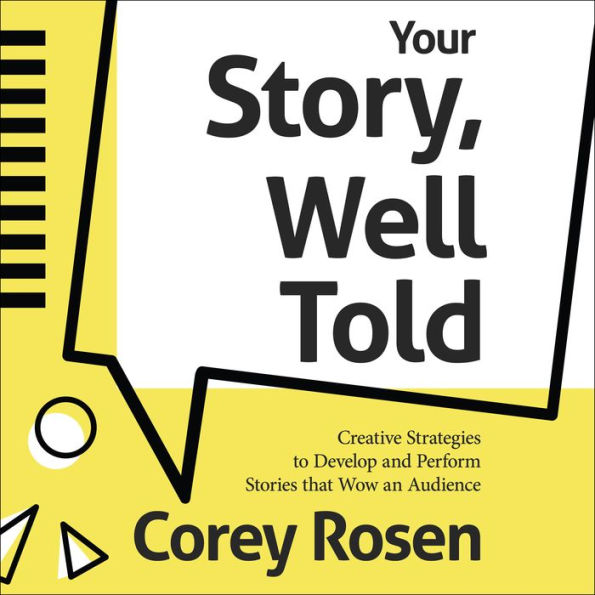Learn how to tell a good story with Your Story, Well Told! Jam-packed with some of the best storytelling strategies, this manual gives creatives the confidence bump they need to make the sale, land the client, propose a toast, or impress their date.
The following is (not) a work of fiction. We've all got stories to tell-but how do you make your story the best story? In Your Story, Well Told!, Moth veteran Corey Rosen inspires you to get on stage and tell your story. Using the best storytelling techniques from improvisational theater, Rosen designs an accessible guide for all ages and skill levels. Crafted to help ordinary people tell extraordinary stories, this laugh out loud handbook covers everything from how to tell a good story to going off script.
Spontaneous stories to tell. The best storytelling uses improvisation to enthrall, entertain, and keep audiences on edge. Laugh along with tales of performance triumphs (and disasters) and explore ways to tell your story with confidence and spontaneity. From brainstorming and development to performance and memorization techniques, you'll learn how to tell a good story with a variety of structures and editing approaches that bring out your best story; improv exercises to stimulate creativity without feeling foolish; and quick and easy lessons on building stories to tell.
1137916803
The following is (not) a work of fiction. We've all got stories to tell-but how do you make your story the best story? In Your Story, Well Told!, Moth veteran Corey Rosen inspires you to get on stage and tell your story. Using the best storytelling techniques from improvisational theater, Rosen designs an accessible guide for all ages and skill levels. Crafted to help ordinary people tell extraordinary stories, this laugh out loud handbook covers everything from how to tell a good story to going off script.
Spontaneous stories to tell. The best storytelling uses improvisation to enthrall, entertain, and keep audiences on edge. Laugh along with tales of performance triumphs (and disasters) and explore ways to tell your story with confidence and spontaneity. From brainstorming and development to performance and memorization techniques, you'll learn how to tell a good story with a variety of structures and editing approaches that bring out your best story; improv exercises to stimulate creativity without feeling foolish; and quick and easy lessons on building stories to tell.
Your Story, Well Told!: Creative Strategies to Develop and Perform Stories that Wow an Audience
Learn how to tell a good story with Your Story, Well Told! Jam-packed with some of the best storytelling strategies, this manual gives creatives the confidence bump they need to make the sale, land the client, propose a toast, or impress their date.
The following is (not) a work of fiction. We've all got stories to tell-but how do you make your story the best story? In Your Story, Well Told!, Moth veteran Corey Rosen inspires you to get on stage and tell your story. Using the best storytelling techniques from improvisational theater, Rosen designs an accessible guide for all ages and skill levels. Crafted to help ordinary people tell extraordinary stories, this laugh out loud handbook covers everything from how to tell a good story to going off script.
Spontaneous stories to tell. The best storytelling uses improvisation to enthrall, entertain, and keep audiences on edge. Laugh along with tales of performance triumphs (and disasters) and explore ways to tell your story with confidence and spontaneity. From brainstorming and development to performance and memorization techniques, you'll learn how to tell a good story with a variety of structures and editing approaches that bring out your best story; improv exercises to stimulate creativity without feeling foolish; and quick and easy lessons on building stories to tell.
The following is (not) a work of fiction. We've all got stories to tell-but how do you make your story the best story? In Your Story, Well Told!, Moth veteran Corey Rosen inspires you to get on stage and tell your story. Using the best storytelling techniques from improvisational theater, Rosen designs an accessible guide for all ages and skill levels. Crafted to help ordinary people tell extraordinary stories, this laugh out loud handbook covers everything from how to tell a good story to going off script.
Spontaneous stories to tell. The best storytelling uses improvisation to enthrall, entertain, and keep audiences on edge. Laugh along with tales of performance triumphs (and disasters) and explore ways to tell your story with confidence and spontaneity. From brainstorming and development to performance and memorization techniques, you'll learn how to tell a good story with a variety of structures and editing approaches that bring out your best story; improv exercises to stimulate creativity without feeling foolish; and quick and easy lessons on building stories to tell.
19.99
In Stock
5
1

Your Story, Well Told!: Creative Strategies to Develop and Perform Stories that Wow an Audience

Your Story, Well Told!: Creative Strategies to Develop and Perform Stories that Wow an Audience
FREE
with a B&N Audiobooks Subscription
Or Pay
$19.99
19.99
In Stock

Product Details
| BN ID: | 2940176270136 |
|---|---|
| Publisher: | Ascent Audio |
| Publication date: | 04/13/2021 |
| Edition description: | Unabridged |
Videos

From the B&N Reads Blog
